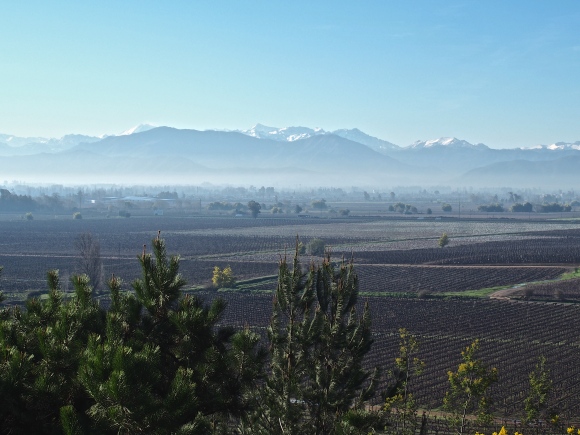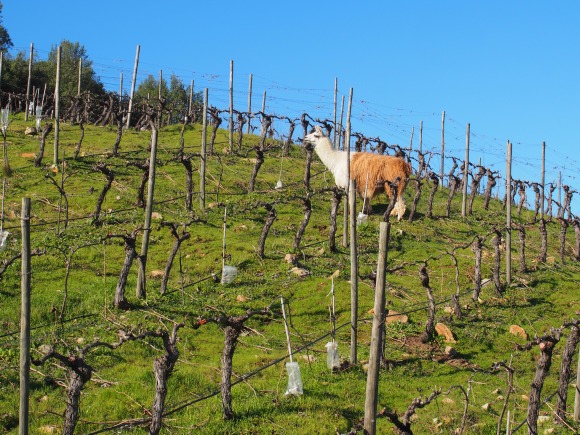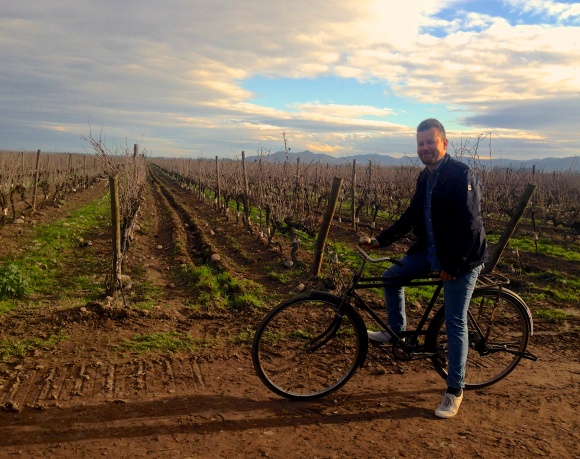“Those? They are just hills”, Susana, my expert guide for the trip says and points her finger towards the two kilometre high mountains bordering the million city of Santiago, while simultaneously changing lanes on the motorway without looking too much at the mirrors.
Things are relative, traffic cultures, mountains and seasons. I feel dizzy. Too much coffee and too poor sleep. A day ago, I was enjoying the summer in Finland, but now I’m in the middle of Chilean winter. It seems vague, almost impossible. I slept on the plane like a dog across the Atlantic, only momentarily waking up because of the turbulence, which reminded me of the fate of the notorious Air France flight. I tried not to think about it and tried to find a position that would not kill the back of my neck.
I feel hungry cause I didn’t eat in the plane. I did open the foil of my dinner but felt my courage leave as I saw the contents. Instead of eating I found myself poking a meatball around with a disposable fork. Eating must wait a bit longer, because I didn’t come this far for nothing. I came to taste wine.
This is the way my first trip to Chile started. It is today coming to an end, and contrary to my prior assumptions, I found myself inspired by Chilean wine industry multiple times. It made my mind move restlessly, which is why I ended up using the week to understand the details of Chilean wine but also trying to understand my own reaction. Now, sitting at the Santiago airport, my thoughts about Chile are surprisingly lucid.
Am I after the experience a sworn advocate for Chilean wines? I’m not, at least not yet. I’ll give you some examples. The Chile’s most revered wine style, Maipo Valley’s full bodied and minty Cabernet sauvignon still leaves me lukewarm. And I still do not find Carmenere variety very interesting, although it is at its best mouth-filling and luscious (and reasonably often free of bell pepper pyrazines, if harvested in May).
Many producers make very commercial style wines and sometimes unnecessarily so. This means that they don’t manufacture the best possible wines from the grape material, but rather that they manufacture wines, which do not irritate even the consumer with a crappy taste. Because you can’t please everybody, the winelovers end up feeling lukewarm in front of the soft, round and even sweet style (points to Vina Maipo for the fact that even their affordable red wines are dry). At worst, this means ruining good raw material in the cellar. A tank sample can be a reasonable bright and palatable, but the end product modest.
In order to step up its game, Chile should be able to first break away from the gravity of its own image. In the end this will be decided by the consumers in their willingness to upgrade, since wine sector is a similar hostage to the markets as any commodity producing industry.
On the other hand it is important to ask whether I still feel the same way about Chilean wines than I did a week ago while packing winter clothes for Santiago. The answer is no. During the days, I realised that, in spite of the Chilean wine history reaching all the way to the conquistadors, the wine industry is infact very very young.
The most significant steps in the wine industry are barely 20 years old. It is a short period of time compared to many other wine-producing countries and this makes Chile special. Adolescence means uncertainty and incompleteness, if anything, but offers a great possibility for potential yet actualised, if even found.
Following anecdotes tell the story. When the producing of icon wines became more common at the end of the 1990s, some producers didn’t save any bottles in their own libraries, as is generally customary. The thought hadn’t even appeared to them, since they were happy the people were willing to buy all their bottles, with a nice price tag. This led to an absurd situation. Valdivieso, known for its quality sparkling, reds and whites, had to buy some bottles of their solera style made Caballo loco back from dealers at the market rate. First they produced the wine and sold it for a good profit. Then they end up wasting the profits by buying some bottles back on higher price they got from it in the first place.
Another example I heard from the talented Matia Rios, who’s a winemaker at the organic powerhouse Cono sur. He told that before the year 1999 when Cono Sur started a quality revolution in Pinot everybody were making Pinot noir like it was Cabernet sauvignon. The delicate nature of the variety was not understood and producers were pushing for maximum extraction, colour and weight on the palate. The results some times tasted like onion jam. Tasting the 20 Barrel Pinot noir or their iconic Ocio, this seems like far away past. Ocio does come with body, but it’s at the same time ethereal, focused wine that floats through the palate leaving behind only a tingle of fine tannins as a bitter reminder of the fact, that the delicious wine was, but already went.
It should be noted that although some continue to manufacture the jammy over ripe style, properly produced Pinot has become something of a phenomenon. As a token of the speed of transformation, it is quite telling that they used to produce 1999 Pinot like Cabernet, but 2014 they vinify Syrah like Pinot, in an open top tanks.
The lighter and more pure trend can be seen in for example in the Pinots of Castillo de Molina which come with bright red fruit and nice drinkability. More interesting than the wines coming from the somewhat warm Curico, are however wines of Maycas del Limari. Maycas, though on paper an operation of the giant Concha y Tori, is a quality focused boutique winery producing annually only 20.000 cases.
I was able to locate four trends that are shaping the Chilean industry at the moment in interesting ways. Since they all seem to be embodied in Maycas del Limari, I’ll present them through their operation in the Limari region.
1. Earlier harvesting time
According to the wine maker Marcelo Papa, the style of Limari has evolved and become recognisable the past few years. This seems indeed to be the case. In the first vintage, 2007, the wines of Maycas represented more ripe style, but it has changed tremendously and for the better, if I may add. The Chardonnay used to be harvested on the first week of March but is now picked already mid-February. So this means three weeks, no less, earlier than just a couple of years ago. This has radical implications in the wine. It means freshness on the palate, piercing acidity and brightness of the fruit. Citric notes instead of tutti frutti tropical mix. In other words, the structure has been enhanced in detriment of the fruit, which has lead, in the case of relatively warm Chile, in to wines with better balance. It’s pretty telling that their Sumaq Chardonnay 2013 is on the palate closer to freshly squeezed lime than papaya, but still dexterous, rich and focused.
Maycas del Limari’s Sumaq Pinot noir 2013 is on its own level in the quality per price charts. In my experience, such quality is hard to find in Pinot noirs from other parts of the wine world. French Pinots from Burgundy, Alsace or Loire are more expensive. Californian Pinot tends to be soupy on my palate on the affordable price range and Pinots from New Zealand sometimes have this tense grape fruit character that puts me a bit off and makes them seem like German Spätburgunders on steroids, which by the way, rarely if ever come in the same price range as Sumaq.
2. Less oak
I remember tasting Maycas del Limari couple of years earlier and though I recognised the quality, I had problem with the amount of oak that seemed to cover the purity of the fruit with a layer of coconut. The situation has obviously changed, because new oak flavours are no longer considered something necessary for a wine to flourish. In their top of range wines, oak is still somewhat too present for my taste, but the direction they are going is nothing short of exciting.
3. Planting varieties where they fit best
Not so long ago Chilean vines were mostly planted to answer to the demand of the market: If consumers were thirsty for Pinot noir, the vines were planted. Sometimes in places where there was only one moment ago Merlot. The end results are not so hard to guess. Limari, cooled down by the ocean and with its limestone soils and morning cloudiness, cannot ripen Merlot. Maycas grows only Chardonnay, Pinot and Syrah (out of which the latter is less interesting than the previous ones). The direction is clear: from market driven to site specific matches to ensure the best possible quality.
4. Finding new wine regions
The Chilean producers have certainly noticed a long time ago that easy growing conditions don’t necessarily translate to refined quality, which is why they are looking for cooler regions. In Chile this means often going closer to the ocean or higher in altitude, mostly on the slopes of the Andes. Montes has an interesting line called Outer Limits, which explores these possibilities. Their Sauvignon blanc from a new wine region near the Pacific is outstanding. Where as Leyda Sauvignon blanc tends to be mostly about the primary characteristics of the variety in a New Zealand Marlborough style, Zapallar version is chalky, elegant, piercing and long in a style more reminiscent of Sancerre, France.
One must also mention Vik, a megalomanic venture started by a Norwegian tycoon in Millahau. They’ve planted close to 400 hectares of vineyard and have a modest goal of producing the best wine in the world. They make only one wine, an expensive red blend nodding in style to the direction of the big boys in Bordeaux. Though a young project, the results are quite impressive and I’m looking forward to hearing what the king making wine journalists in the States will say when Vik is launched to them according to the strategy of the estate.
Movi, the collaborative entity of independent Chilean wine makers is something one cannot bypass in the year 2014. Forget about large crops, high volumes, drip irrigation or consumer friendly expressions. Movi is equivalent of only 0,05% of Chile’s wine exports but works as a peeking hole to the otherness of Chilean wine. In my opinion Movi is something the brand Chile needs to step up its game also on commercial level. Weeds in the garden are sometimes for the benefit of the perfectly trimmed trees.

These four trends are changing the landscape of Chile as we speak, but they are of course not a magic wand. You can harvest earlier, use oak in more refined manner, understand your soils better and find totally new regions, but if the soil your vines are growing on, isn’t suitable for quality wine, there’s not much you can do.
One has to ask whether Chile of the future has to produce in such volume as in today? Maybe fifteen years from now the wine experts raving about new quality regions of Chile have already started to forget that Chile used to be known for volume more than quality? I should certainly hope so. The potential definitely is there. The wine industry is not yet mature, but that can also be seen as a great thing, since an era of discovery means also rapid progress.
One thing is clear: the Chilean winemakers have no intention to be remembered by the history as mostly mass producers. They are too talented, have too much passion and the perfect natural setting for that. For this reason alone there’s no reason to under line with permanent ink the fact that Chile is in between quantity and quality. Chile is still offering uncharted terroirs and untapped potential many more established wine countries can only dream about. If present is the best estimate for the future, Chile’s tomorrow seems bright indeed.
Disclaimer: the trip was done in collaboration with Chilean producers.



